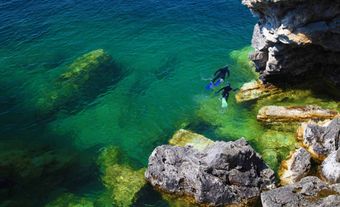Mansel Island, 112 km long by 48 km wide, is the smallest of 3 islands lying across the entrance to HUDSON BAY. Its topography features a gently undulating limestone lowland with elevations not exceeding 100 m. The entire island was submerged under higher sea levels at the end of the last glaciation. A legacy of this marine transgression is the particularly striking relic beach deposits and elevated former shoreline features. The island itself is an outcrop of ancient resistant marine sediments and is part of an elongated escarpment extending 725 km along the north and east margin of Hudson Bay.
-
- MLA 8TH EDITION
- Finlayson, Douglas. "Mansel Island". The Canadian Encyclopedia, 23 January 2014, Historica Canada. www.thecanadianencyclopedia.ca/en/article/mansel-island. Accessed 23 October 2024.
- Copy
-
- APA 6TH EDITION
- Finlayson, D. (2014). Mansel Island. In The Canadian Encyclopedia. Retrieved from https://www.thecanadianencyclopedia.ca/en/article/mansel-island
- Copy
-
- CHICAGO 17TH EDITION
- Finlayson, Douglas. "Mansel Island." The Canadian Encyclopedia. Historica Canada. Article published February 07, 2006; Last Edited January 23, 2014.
- Copy
-
- TURABIAN 8TH EDITION
- The Canadian Encyclopedia, s.v. "Mansel Island," by Douglas Finlayson, Accessed October 23, 2024, https://www.thecanadianencyclopedia.ca/en/article/mansel-island
- Copy
Thank you for your submission
Our team will be reviewing your submission
and get back to you with any further questions.
Thanks for contributing to The Canadian Encyclopedia.
CloseArticle
Mansel Island
Article by Douglas Finlayson
Published Online February 7, 2006
Last Edited January 23, 2014
Mansel Island, 112 km long by 48 km wide, is the smallest of 3 islands lying across the entrance to HUDSON BAY. Its topography features a gently undulating limestone lowland with elevations not exceeding 100 m.

 Share on Facebook
Share on Facebook Share on X
Share on X Share by Email
Share by Email Share on Google Classroom
Share on Google Classroom

